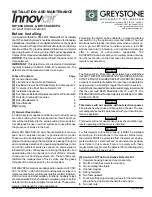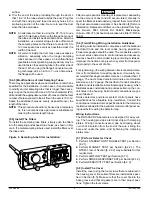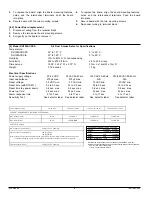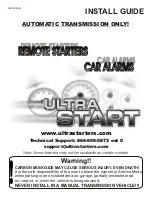
D100-68-00 Revision Date: 12-06-99
1
I56-1525-000
DH100ACDCIA & DH100ACDCPA
Air Duct Smoke Detector
INSTALLATION AND MAINTENANCE
Before Installing
ULC standard CAN/ULC-S524-M91 “Standard For The Installa-
tion Of Fire Alarm Systems” should be referenced for Canadian
Installations information. For additional reference the System
Sensor
Guide for Proper Use of Smoke Detectors in Duct Ap-
plications (I56-473), provides detailed information on detector
spacing, placement, zoning, wiring, and special applications.
Copies of this manual are available from System Sensor.
NOTICE: This manual should be left with the owner/user of
this equipment.
IMPORTANT: This detector must be tested and maintained
regularly following CAN/ULC-S536-97 requirements. The
detector should be cleaned at least once a year.
Table of Contents
Page
[1] General Description
1
[2] Limitations of Duct Smoke Detectors
1
[3] Exploded View of Duct Smoke Detector Components 2
[4] Contents of the Duct Smoke Detector Kit
2
[5] Installation Sequence
2
[6] Duct Smoke Detector Maintenance and Test Procedures5
[7] Detector Cleaning Procedures
7
[8] Board Replacement
8
[9] Specifications
8
[10] Warranty
8
[1] General Description
An HVAC system supplies conditioned air to virtually every
area of a building. Smoke introduced into this air duct sys-
tem will be distributed to the entire building. Smoke detec-
tors designed for use in air duct systems are used to sense
the presence of smoke in the duct.
Model DH100ACDCA Air Duct Smoke Detectors are sup-
plied as an ionization model or photoelectronic model.
These two smoke detection methods are combined with an
efficient housing design that samples air passing through a
duct and allows detection of a developing hazardous condi-
tion. When sufficient smoke is sensed, an alarm signal is
initiated at the fire control panel monitoring the detector, and
appropriate action can be taken to shut off fans, blowers,
change over air handling systems, etc. These actions can
facilitate the management of toxic smoke and fire gases
throughout the areas served by the duct system.
DH100ACDCA detectors are designed to operate on 24 VDC/
VAC, 120 VAC, or 240 VAC. Alarm and supervisory relay con-
tacts are available for control panel interface (alarm initiation),
HVAC control, and other auxiliary functions. Auxiliary relays
are also provided for fan shut down or signaling of up to 9 other
detectors in the loop for multiple fan shut down. These detec-
For testing, the alarm can be enabled by a magnet activated
test switch or by the optional remote test station. The duct
smoke detector latches into alarm state when an alarm oc-
curs. A green LED flashes to indicate power, a red LED
signals local alarm indication, and optional accessories
offer a variety of annunciation capabilities. The
DH100ACDCA can be reset by a momentary power interrup-
tion, the reset button on the front cover, the control panel, or
remote reset accessory.
[2] Limitations Of Duct Smoke Detectors
WARNING
The National Fire Protection Association has established
that DUCT DETECTORS MUST NOT BE USED AS A SUB-
STITUTE FOR OPEN AREA DETECTOR PROTECTION as
a means of providing life safety. Nor are they a substitute for
early warning in a building’s regular fire detection system.
System Sensor supports this position and strongly recommends
that the user read NFPA Standards 90A, 72, and 101. The
DH100ACDCA Air Duct Smoke Detectors are listed per UL 268A
& CAN/ULC-S529
WARNING
This device will not operate without electrical power.
Fire situations may cause an interruption of power. The sys-
tem safeguards should be discussed with your local fire pro-
tection specialist.
WARNING
This device will not sense smoke unless the ventilation sys-
tem is operating and the cover is installed.
WARNING
For this detector to function properly, it MUST be installed
according to the instructions in this manual. Furthermore,
the detector MUST be protected from the elements and op-
erated within ALL electrical and environmental specifica-
tions listed in this manual. Failure to comply with these
requirements may prevent the detector from activating when
smoke is present in the air duct.
[4] Contents Of The Duct Smoke Detector Kit
1. Complete housing base and cover assembly
2. Two #10 machine screws for mounting
3. Two sampling tube filters
4. One test magnet
5. Drilling template
6. Two foam gaskets
7. Four #6-self tapping mounting screws for the metal sam-
pling tube and optional exhaust tube extension
8. Two jack nuts
150 English Drive, Moncton, NB, E1E 4G7 CANADA
tel: 506-853-3057 fax: 506-853-6014
e-mail: [email protected]
www.greystoneenergy.com
tors are not designed for 2-wire applications.


























